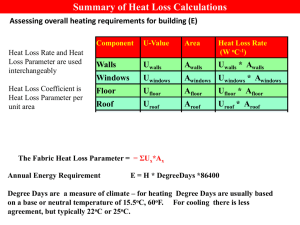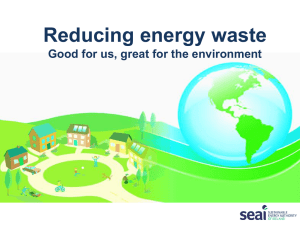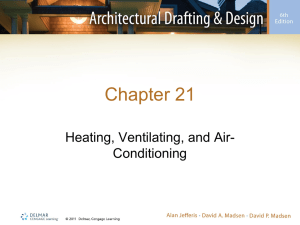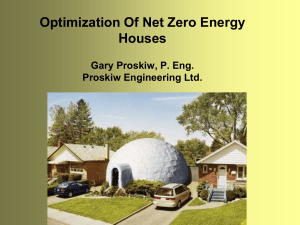Comprehensive Study
advertisement
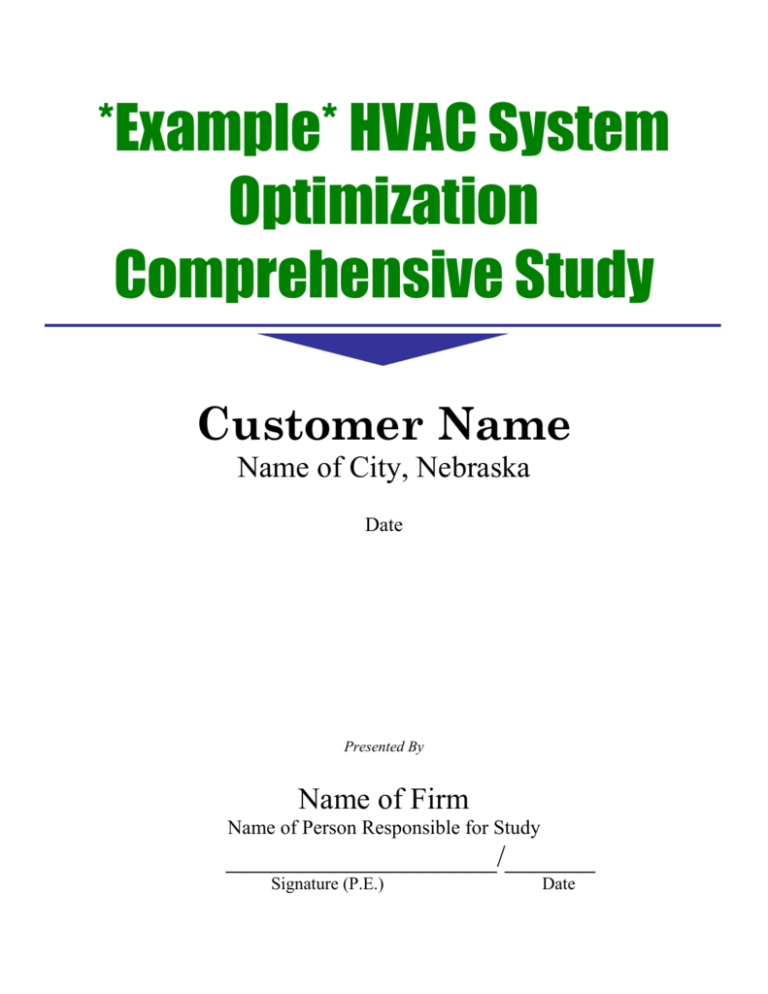
*Example* HVAC System Optimization Comprehensive Study Customer Name Name of City, Nebraska Date Presented By Name of Firm Name of Person Responsible for Study __________________/______ Signature (P.E.) Date Table of Contents Executive Summary ............................................................................................ 3 Introduction ......................................................................................................... 4 Disclaimer ........................................................................................................... 4 Building Data ...................................................................................................... 4 Current Energy Data and Charts ......................................................................... 5 Current Energy Usage Allocations ..................................................................... 8 ENERGY STARTM Energy Performance Rating ............................................... 8 Assessment and Findings .................................................................................... 9 Energy Conservation Measures .......................................................................... 9 Measurement and Verification Plan ................................................................. 11 Documentation .................................................................................................. 12 Training ............................................................................................................. 12 Case Study ........................................................................................................ 12 Conclusion ........................................................................................................ 12 Attachments: ENERGY STAR Statement of Energy Performance ENERGY STAR Data Checklist for Commercial Buildings 2 Executive Summary A HVAC System Optimization Study was completed by name of firm for name of customer. This study recommends improvements to the heating, ventilating, and air-conditioning (HVAC) systems that will reduce the energy usage of the facility. The recommended improvements include: ECM No. 1: Upgrade the air distribution system in the original building to variable air volume (VAV). This will be accomplished by the installation of variable frequency drives on air handling unit number 1 supply and return fans. Additionally, dampers with electric actuators will be installed in the existing constant volume terminal boxes, with dampers connected to the existing direct digital control (DDC) system. ECM No. 2: Reduce AHU-1 duct static pressure. A summary of the estimated ECM energy savings, costs, and paybacks is shown below: ECM Description Annual Electrical Energy Savings (kWh) Monthly Electrical Demand Savings (kW) Annual Natural Gas Savings (Therms) Estimated Estimated Cost To Savings Implement1 ($) ($) Simple Payback2 (Years) 1 – Upgrade to VAV 2 – AHU-1 Static Pressure 1 Actual cost to be determined by service provider. 2 Incentives may be available through your local electric utility that could lower this payback time. 3 Introduction HVAC System Optimization is a systematic process for investigating heating, cooling, and ventilating (HVAC) systems in existing buildings, and implementing recommendations which will improve their performance. The first step in the process is to complete a study of these systems. This study will serve as the basis for potential incentive payments through name of customer’s electric utility. The goals of the HVAC System Optimization program are to: Save the customer money through lower utility bills by reducing electric demand, electricity consumption, and fossil fuel (e.g., natural gas) consumption Improve comfort of the building occupants Educate and train building maintenance staff Ensure proper documentation of changes made The HVAC System Optimization process is estimated to require insert number hours of name of customer’s maintenance staff time, which is needed for gathering of data, assisting with measurements, education and training, and review of documentation. Disclaimer The information provided in this study is based on conditions observed at the time of the study, standard energy efficiency calculation methods, and current equipment cost estimates. Actual savings will depend on many factors, including but not limited to: energy conservation measures implemented, variations in climatic conditions, changes in fuel prices, and energy use practices of the building occupants. Actual equipment costs will depend on bid prices from a service provider(s). While this document has been prepared with technical accuracy, no guarantee of cost savings, reduction in total energy consumption, or equipment cost is made by the service provider or the electric utility. Building Data Name of customer consists of the following buildings: Original building (built in 1970) First addition (built in 2000) Total Area 20,000 square feet 10,000 square feet 30,000 square feet Attached is a floor plan of the building (optional). Administration and Operations: Use of building: describe use (e.g., school, office space, etc.) Normal hours of operation: (e.g., 8:00 a.m. to 5:00 p.m.), (e.g., Monday through Friday). Number of full time occupants: number Percent of building that is unheated: number Percent of building that is not air-conditioned: number Description of Heating, Ventilating, and Air-Conditioning (HVAC) Systems: Describe HVAC systems (e.g., The original building is cooled by an air-cooled chiller, and heated by a natural gas boiler. A single duct constant volume air handling unit provides air to 4 constant volume terminal boxes with hot water reheat coils. The system is controlled by a pneumatic control system. The second addition is served by a water source heat pump system, with heat added by the original building’s natural gas boiler, and heat rejected to a cooling tower. Outside air is supplied to the addition via an energy recovery unit. The system is controlled by a DDC system.) Current Energy Data and Charts The facility has one electric meter. Uses of electricity include cooling, heating, lighting, plug loads, and other general electrical needs. The facility also has one natural gas meter. Natural gas is used for building heating and water heating. The charts following the table show the electricity consumption and demand, and natural gas usage, in graphical format. Two or more years of energy data is preferred. Name of Customer Month Jan-08 Feb-08 Mar-08 Apr-08 May-08 Jun-08 Jul-08 Aug-08 Sep-08 Oct-08 Nov-08 Dec-08 Totals: Number of Days Electricity Consumption (kWh) 31 29 30 31 31 30 30 32 30 31 31 30 366 38,480 42,400 29,520 30,400 32,960 35,422 42,388 36,720 36,240 32,880 35,280 35,120 427,810 5 Demand (kW) Electric Billing 137 127 118 103 121 131 149 142 136 125 110 114 $1,577.68 $1,738.40 $1,210.32 $1,278.62 $1,386.30 $2,556.00 $3,080.00 $2,646.04 $2,611.45 $1,382.93 $1,483.88 $1,615.52 $22,567.14 Cost Per Load kWh Factor $0.041 $0.041 $0.041 $0.042 $0.042 $0.072 $0.073 $0.072 $0.072 $0.042 $0.042 $0.046 $0.053 0.38 0.48 0.35 0.40 0.37 0.38 0.40 0.34 0.37 0.35 0.43 0.43 Electricity Consumption (kWh) 45,000 40,000 35,000 30,000 25,000 20,000 15,000 10,000 5,000 0 Electricity Demand (kW) 160 140 120 100 80 60 40 20 0 6 Name of Customer Month Jan-08 Feb-08 Mar-08 Apr-08 May-08 Jun-08 Jul-08 Aug-08 Sep-08 Oct-08 Nov-08 Dec-08 Gas Consumption (therms) Gas Billing Cost Per Therm 2,522 2,015 1,355 553 251 195 184 179 192 289 757 2,350 10,842 $3,288.00 $2,645.00 $1,746.00 $715.00 $325.00 $257.00 $243.00 $234.00 $254.00 $371.00 $995.00 $3,111.00 $14,184.00 $1.30 $1.31 $1.29 $1.29 $1.29 $1.32 $1.32 $1.31 $1.32 $1.28 $1.31 $1.32 $1.31 Natural Gas Consumption (therms) 3,000 2,500 2,000 1,500 1,000 500 0 Energy Usage Indices: Electricity Consumption (kWh/sqft) Maximum Electricity Demand (Watts/sqft) Natural Gas Consumption (therms/sqft) Total Energy Consumption (Btus/sqft) Total Energy Cost ($/sqft) 14.3 5.0 .36 84,811 $1.23 7 Current Energy Usage Allocations Electrical Energy Consumption (kWh) Allocation: Space Kitchen Heating, Equipment, 30,000 20,000 Lighting, 125,000 Space Cooling, 112,810 Plug Loads, 70,000 Ventilation, 70,000 Natural Gas Consumption (therms) Allocation: Kitchen Equipment, 1,200 Water Heating, 2,000 Ventilation, 1,500 Space Heating, 6,142 ENERGY STARTM Energy Performance Rating Energy consumption and other required information has been entered into the U.S. Environmental Protection Agency/Department of Energy’s ENERGY STAR benchmarking program. This building has received an Energy Performance Rating of number. Buildings that receive a rating of 75 or higher are considered “ENERGY STARTM”. A Statement of Energy Performance and Data Checklist are attached to this study. 8 Assessment and Findings A detailed site assessment was conducted, including measurements of air and water systems, functional tests to verify equipment operation, and collection of design and operating data. Instances of poor occupant comfort were also noted. One line schematics of the HVAC systems are included as appropriate to describe the systems. Original Building: AHU-1: Design information (e.g., supply fan 20,000 cfm, 4” s.p.; return fan 15,000 cfm, 2.5” s.p.) Measurements: cfm, s.p., temperatures, volts, amps Chiller: Design information Measurements: Boiler: Design information Measurements: Heating water pumps: Design information Measurements: (e.g., Heating water pumps operate continuously during the heating season. enabled when outdoor air temperature is 60°F or less.) Pumps are Addition: Cooling tower: Design information Measurements: Energy Recovery Ventilator: Design information Measurements: (e.g., A review of the DDC system indicates occupied schedule is from 5:00 a.m. to 10:00 p.m. Night setback temperatures are not being utilized.) Energy Conservation Measures Calculations based on engineering principles and reliable field data are the foundation for the savings reported by the HVAC System Optimization Program. Therefore, the engineering calculations must be based on reliable data, sound principles, and good judgment in the use of assumptions. The effects of interactions among Energy Conservation Measures are to be included where applicable. ECM No. 1: Install variable frequency drives on air handling unit number 1 supply and return fans. Convert constant volume terminal boxes served by air handling unit 1 to variable air volume. 9 Calculations of Current Energy Consumption: (Attach separate sheets as needed) Calculations of Energy Consumption following implementation of ECM: (Attach separate sheets as needed) ECM No. 2: Reduce AHU-1 duct static pressure. Calculations of Current Energy Consumption: (Attach separate sheets as needed) Calculations of Energy Consumption following implementation of ECM: (Attach separate sheets as needed) Summary: Electrical Savings: Summer is June through September. ECM No. Summer Energy Savings (kWh) Summer Energy Savings ($) Winter Energy Savings (kWh) Winter Energy Savings ($) Summer Demand Savings (kW) 1 2 3 Totals 10 Summer Demand Savings ($) Winter Demand Savings (kW) Winter Demand Savings ($) Total Electric Savings ($) Total Energy Savings (kWh) Natural Gas Savings: ECM No. Annual Natural Gas Savings (Therms) Natural Gas Savings ($) 1 2 3 Totals Payback: ECM No. Total Electric and Natural Gas Savings ($) Estimated Cost To Implement ($) Simple Payback (Years) 1 2 3 Totals Measurement and Verification Plan Measurement and verification shall be completed in using the International Performance Measurement and Verification Protocol, April 2007, as a guide. Typically, Measurement and Verification (M&V) Option B or C will be used. M&V Option B is intended for retrofits with performance factors (e.g., end-use capacity, demand) and operational factors (e.g., operating hours) that can be measured at the component or system level and where long-term performance needs to be verified. It uses periodic or continuous metering of all energy quantities, or all parameters needed to calculate energy, during the performance period. M&V Option C involves whole-facility or sub-meter data analysis procedures to verify the performance of retrofit projects in which whole-facility baseline and performance period data are available. Option C usually involves collecting historical whole-facility baseline energy use and related data and continuously measuring whole-facility energy use after ECM installation. It is typically used when energy savings are expected to be significant (i.e., 10% or 11 more of consumption measured by the utility meter). M&V Option D, calibrated simulation, may need to be used if a facility is not separately metered. Cost Savings = Cb – Cr Where: Cb = Cost of the baseline energy plus any adjustments Cr = Cost of the reporting period energy plus any adjustments Costs are determined by applying the same price schedule in computing both Cb and Cr. The full price structure should be applied in the determination of cost savings, especially when using Options C and D. The energy rates to be used in valuing saved energy shall be based on current energy rates, unless spelled out otherwise. The measurement and verification plan is described in detail as follows: Documentation The following is a description of the documentation to be provided: changes made to building systems equipment shop drawings/O&M manuals new control sequences and operating procedures Training The following training will be provided: variable air volume system heating water pumps w/ VFDs DDC system Date: _________ Date: _________ Date: _________ Case Study A case study will be provided after one year of operation following implementation of the ECMs. The case study will compare baseline energy consumption to post HVAC system optimization energy consumption. The energy comparison will account for weather differences and other factors as described in the measurement and verification plan. Conclusion This study describes energy conservation measures that, upon implementation, will provide energy savings for your facility. Your local utility will determine the incentives that are applicable based on the information contained in this study. 12

